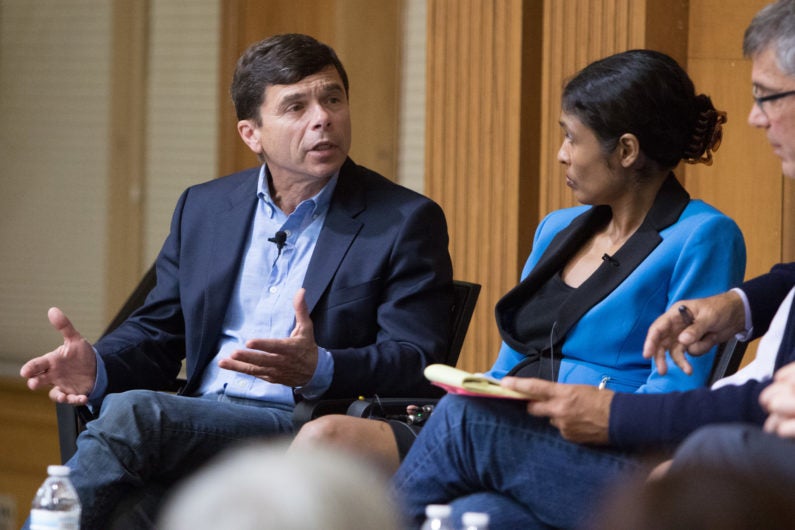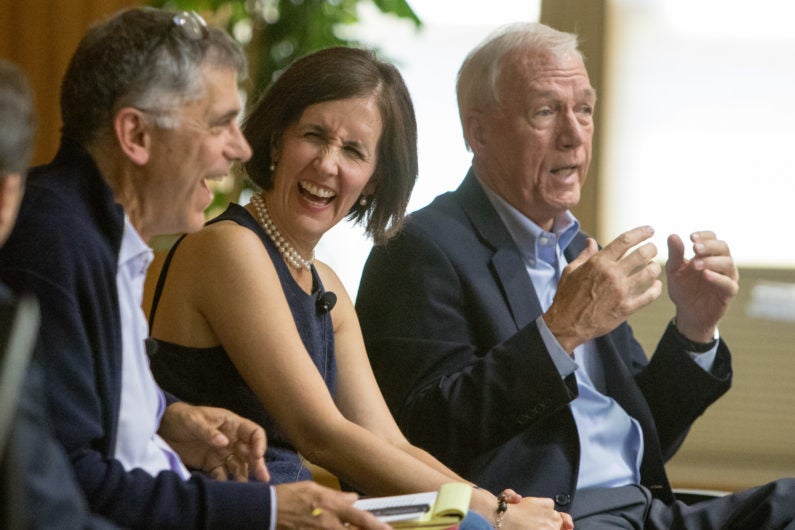Future of investigative reporting focused on collaboration, big data technology, experts say at Stanford panel
Investigative storytelling that questions society’s most powerful interests depends on collaboration and technology, panelists at Stanford’s John S. Knight Journalism Fellowships Reunion and 50th Anniversary Celebration said on Thursday.
The power of media collaboration and big data technology is shaping the future of investigative journalism, experts said Thursday at a Stanford panel discussion.
The session, “Shining a New Spotlight: Innovations in 21st-Century Investigative Reporting,” kicked off three days of dialogue and discussions for the John S. Knight Journalism Fellowships (JSK) Reunion and 50th Anniversary Celebration. The occasion also marked a final salute to retiring Director Jim Bettinger, who has led the JSK fellowships program since 2000.

Michael Rezendes of the Boston Globe and Mary Rajkumar of the Associated Press were among the alumni of the John S. Knight Journalism Fellowships program participating in a panel discussion of innovations in investigative reporting at the program’s reunion and 50th anniversary celebration. (Image credit: Douglas Zimmerman)
In his opening remarks, Bettinger said that investigative reporting is central to journalism’s goal of holding the powerful in society accountable.
On the panel were Walter “Robby” Robinson and Michael Rezendes – two of the four Boston Globe journalists portrayed in the award-winning 2015 movie Spotlight. The JSK alumni led their newspaper’s effort to expose how the Catholic Church conspired to cover up pedophilia by an accused 250 priests in the Boston archdiocese.
The other participants on the panel were Marina Walker Guevara of the International Consortium of Investigative Journalists, and Mary Rajkumar of the Associated Press, who has a master’s degree in journalism from Stanford. Their organizations drew global attention for, respectively, the Panama Papers, which detailed how some of the world’s most powerful people criminally hide money, and Seafood from Slaves, which documented how the seafood industry basically enslaved thousands of workers in Southeast Asia.
John Temple, managing editor at the Investigative Reporting Program at the University of California, Berkeley’s Graduate School of Journalism, moderated the wide-ranging discussion.
“It’s sometimes said that all good journalism is done in the defiance of management,” said Temple, a Knight fellow alumnus, noting how important stories will sometimes flow up from the reporter ranks against skepticism from top editors.
People still matter
Rezendes said that despite all the technological advances of recent years, journalists still depend on the human touch and gaining trust from the people they interview: “You do have to establish relationships of trust and protect your sources.”
The Globe reporter said that he had once worked as a cab driver in Boston, which helped him find common bonds, such as knowing reference points about a source’s neighborhood. At that point, Temple and Robinson chuckled, acknowledging that they, too, had worked as cab drivers in their earlier days.
Rajkumar said journalists’ responsibility to protect their sources is without question.
“It is paramount,” said Rajkumar, the international enterprise editor for the Associated Press who headed the AP team that won the 2016 Pulitzer for their investigation into modern-day slavery, which led to the rescue of more than 2,000 people. She explained how they held their explosive story for weeks and weeks until their sources were out of danger.
Whistleblowers, big data
Guevara lamented the lack of whistleblower protections in countries around the world. The source for the Panama Papers project, for example, could not be public about their identity, due to the danger. Generally, whistleblower protections involve laws that protect people from retaliation for reporting misconduct, typically in their workplaces.

Marina Walker Guevara of the International Consortium of Investigative Journalists discussed her organization’s work on the Panama Papers project with panel moderator John Temple (left) and Walter Robinson of the Boston Globe. (Image credit: Douglas Zimmerman)
The Panama Papers story, which involved a leak of more than 11.5 million financial and legal records, would not have been possible before the advent of technology that can analyze and scrutinize such high volumes of data, said Guevara, whose consortium is a global network of more than 190 investigative journalists in more than 65 countries who collaborate on investigative stories.
“We had the big data tools to do the Panama Papers,” she said.
While media outlets typically viewed each other as competitors in the past, now they can find strength in numbers when they collaborate on complex stories. “We are telling the lone wolf [journalists] to join the pack,” said Guevara.
Rajkumar pointed out that journalism still depends on old-fashioned “shoe-leather” reporting and persistence. Her team had to physically follow seafood trucks and stake out companies for documents – not easy in remote parts of Southeast Asia.
“[Company] documents are a helluva lot easier to get in the U.S. than other countries,” she said, noting how the AP made use of satellite tracking to follow the trucks and ships. “You can’t hide from space.”
Once known mostly for its wire stories, the AP has developed sophisticated tools and relationships to deliver more multifaceted stories. “We have to distinguish ourselves,” said Rajkumar.
Looking ahead
Asked about young, aspiring journalists, Robinson said no other profession offers such meaningfulness.
“There’s nothing like journalism to positively change the world you live in. It’s a lot more fun being a journalist than being in the top 1 percent,” said Robinson, who led the Spotlight team’s Catholic Church investigation that won the 2003 Pulitzer. He is now an editor-at-large for the paper.
Rajkumar observed the importance of social media, user-generated content and big data tools as the next journalistic frontiers.
Rezendes, a reporter for the Spotlight team, said, “The big data has to be brought alive by people.” The most important thing is to get people to talk with the reporter outside of the office, he added. This is a challenge when newsrooms have basically lost half of their reporting staff in recent years.
The Spotlight reporting took place at the dawn of the Internet age, Rezendes said. Then, there were no big data tools, but the simple ability to post online the legal documents involving child molestation by Catholic priests helped readers understand the story. This made the reporters’ findings “bulletproof,” he said.
Robinson said scrutiny should always be given to powerful institutions like the Catholic Church – which he said their 18-month-long series of stories showed had engaged in an “international criminal conspiracy” – as well as the “sacred cows,” political interests and those who hold economic leverage over the weaker in society.
Many big stories are right under our noses, Robinson said. In everyday life, victims may go unnoticed without journalistic attention.
Knight journalism
The rest of the reunion took place Friday and Saturday, July 8-9, with sessions on virtual reality and journalism, and how to improve coverage of race, identity and inequality; a screening of a documentary on how the Chicago school of economics influenced Chile; a dinner honoring Bettinger; and a talk about the future of the John S. Knight Journalism Fellowship program.
Since 1966, more than 900 people have studied as fellows in the program, which explores innovative new ways of storytelling, tools and approaches. Alumni come from across the United States and from countries around the world.
Click here to watch a video of the “Shining a New Spotlight” discussion session.
